I’ve had the opportunity to play with quite a few wacky USB devices in the past few years. Everything from a USB refrigerator and a USB drum kit, to a USB letter opener.
The latest interesting USB gadget to show up on my door step is the USB Hygro-Thermometer from Brando. This flash drive sized device can measure both temperature and humidity.
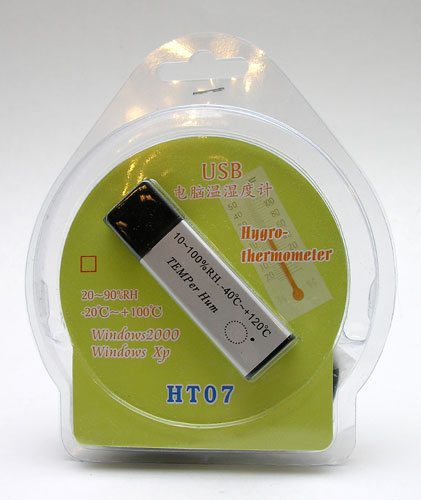
I actually asked Brando to send me this device for review because I have a small but growing collection of ukuleles. These small wooden instruments are sensitive to humidity levels. Several weeks ago I noticed that one of my ukuleles had developed a nasty split on the back. This is something that I’d never had happen in all the years that I’ve had guitars, banjos and dulcimers in my house. I already kept a small inexpensive hygrometer in each of my uke’s cases. Typically, for wooden instruments, you do not want the humidity levels to go below 45%. Whenever I would check the hygrometers in the cases, they would be in the 50-55% level, so I thought I was fine. Then the crack appeared in my Koa Pili Koko uke, even with the hygrometer showing that the humidity in the case was 60%. Grrrrrrr. It was time for a digital hygrometer…
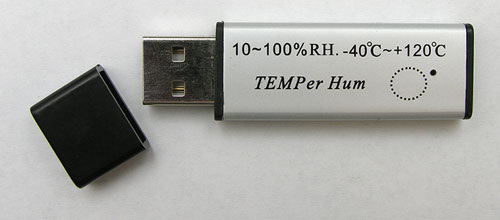
The TEMPer Hum from Brando is a regular USB flash drive sized device that has several small holes drilled in the sides and top to allow it to measure temperature and humidity.
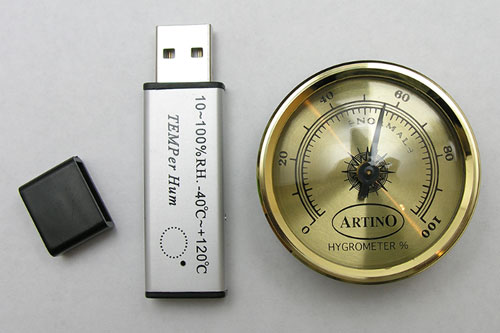
Here it is next to one of the inexpensive non-digital hygrometers that I keep in each instrument case. As you can see by the reading on the non-digital hygrometer, the humidity is approximately 56%. To see what Brando’s digital version measures, you first have to install a small Windows application that is included on a mini CD. Unfortunately for me, there isn’t a Mac version of the app. You also have to download and install .Net framework from Microsoft’s site before you can start viewing measurements.
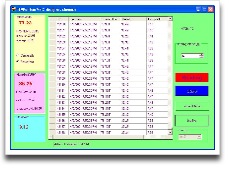
Click thumbnail to see full-size image
Once the application is installed, just plug in the USB TEMPer Hum and click the Start button to start recording data. You can view it in Celsius or Fahrenheit.
Right away I was totally confused by the temperature and humidity readings that this device was displaying. It showed that the temperature down in my basement office (where I keep my ukuleles) was 86 degrees. Ummm, there was no way it was that warm in the basement. It also said that the humidity was only 33.55%. That was wildly different than the 58% reading from the other hygrometer. At first I thought maybe the problem was the fact that I plugged the TEMPer Hum into a USB slot on the back of the notebook computer. Maybe it was reading heat from inside the computer… So I used the included USB extension cable. Unfortunately, that had no noticeable effect. So which device was correct? The TEMPer Hum or the analog meter?
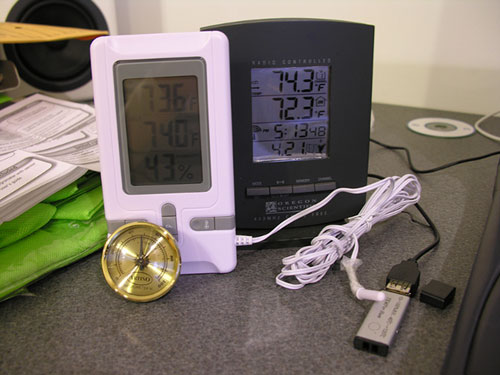
To find out, I decided to go to Radio Shack and buy another digital Thermometer/Hygrometer device, so I could have a third ‘opinion’. I plunked down $20 for a model #63-1032 that you see in the image above. I also brought down another thermometer to add to the mix of measurements. Here’s what they measured:
TEMPer Hum: 33.86% / 86.01F
Analog hygrometer: 48% / (doesn’t measure temperature)
Radio Shack thermometer/hygrometer: 43% / 73.6F
Oregon Scientific Thermometer: (doesn’t measure humidity) / 72.3F
As you will notice, the humidity readings are considerably varied… so much so, that I have absolutely no idea which one (if any) is measuring correctly. I’m not sure I really trust the Radio Shack device since it has both indoor and outdoor temperature sensors and both are in the exact same room and both are showing different results. Go figure.
So the conclusion to this review is that I really can’t recommend the TEMPer Hum USB Hygrometer / Temperature sensor. I know for a fact that it doesn’t measure temperature correctly, and that leads me to guess that it doesn’t measure humidity correctly either. In the mean time, I will hope that Radio Shack and analog hygrometers are accurate enough to trust. As long as I one or the other doesn’t drop below 45% for any length of time, I’ll hope that safe enough for my wooden instruments.
Gerber Gear Suspension 12-in-1 EDC Multi-Plier Multitool with Pocket Knife, Needle Nose Pliers, Wire Cutters and More, Gifts for Men, Camping and Survival, Grey
$58.99 (as of December 20, 2025 18:01 GMT -05:00 - More infoProduct prices and availability are accurate as of the date/time indicated and are subject to change. Any price and availability information displayed on [relevant Amazon Site(s), as applicable] at the time of purchase will apply to the purchase of this product.)Gerber Gear Diesel Multitool Needle Nose Pliers Set, 12-in-1 EDC Multi-Tool Knife, Survival Gear and Equipment, Black
$129.99 (as of December 20, 2025 18:01 GMT -05:00 - More infoProduct prices and availability are accurate as of the date/time indicated and are subject to change. Any price and availability information displayed on [relevant Amazon Site(s), as applicable] at the time of purchase will apply to the purchase of this product.)Product Information
| Price: | 24.0 |
| Retailer: | Brando USB |
| Requirements: |
|
| Pros: |
|
| Cons: |
|



Gadgeteer Comment Policy - Please read before commenting
Here’s a comment that was emailed to me this morning:
One of the things I do for a living is calibrate room sensors for operating rooms at a local hospital. I regularly spend hundreds of dollars on NIST traceable instruments. Portable humidity checkers are the worst. First, it’s called relative humidity because it varies with temperature. RH is actually a measure of how much water the air can hold. At 85 degrees, you can put a lot more water into vapor than you can at 65 degrees. So, if the temp sensor is off, you’ll never get a good humidity reading. Second, it takes a long time for sensors to settle down. 24 hours in not uncommon to wait for a humidity sensor to give an accurate reading. There is no good answer to this problem. You desire to keep your instruments at a 50% humidity is going to require a humidifier. That way the sensor is always active and it has a way to add humidity to make up for any shortfalls. Air Conditioning has a tendency to remove humidity from the air, so I recommend that you come up with a humidity solution before the summer season gets here. To do a single room, an ultrasonic humidifier is probably your best choice, drawbacks include filling the darned thing at least once a day, and it prefers distilled water, regular water will have a tendency to spread dust everywhere. Central humidification is another option, just don’t think that it’s a device that will run forever, hard water deposits will mean replacing the pad at least once a year, and if you have particularly hard water, you may need to do it every month.
Feel free to add this to the comments. I just can’t remember my password to log in and do it. 😛
Brice Ligget
What is the tolerance for calibration of thermometer, RADIO SHACK, model:63-1032.
Check out
http://lounge.cigarfamily.com/showthread.php?t=10215#post167831
(and lots of other places) for a way to calibrate your humidity meter easily – & I think accurately.
Actually, http://lounge.cigarfamily.com/showthread.php?t=10215#post167826 is the better link…